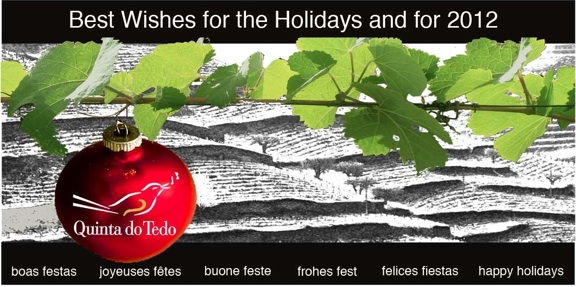L'année dernière, Quinta do Tedo a décidé de replanter 3,23 hectares avec les cépages traditionnels de Porto : Touriga nacional (43 %), Touriga Franca (43 %) et Sousão (14 %). Cette parcelle particulière, Frente da Quinta, sera complétement replantée et réaménagée en terrasses dont certaines le seront avec des murs en pierres.
 La première raison en est, contrairement à mon second blog traitant de la replantation d'une vigne à la fois (cf. le blog de Kay de Septembre 2009), que cette très vieille parcelle n’avait plus que quelques vieux ceps survivants. La seconde raison provient du fait que durant les 2 à 3 dernières années d'étés aux chaleurs torrides, lors desquelles nous avons voulu replanter des vignes suivant la tradition d'une à l’époque, elles n'ont pas pu survivre à la chaleur estivale dans un sol trop compact.
La première raison en est, contrairement à mon second blog traitant de la replantation d'une vigne à la fois (cf. le blog de Kay de Septembre 2009), que cette très vieille parcelle n’avait plus que quelques vieux ceps survivants. La seconde raison provient du fait que durant les 2 à 3 dernières années d'étés aux chaleurs torrides, lors desquelles nous avons voulu replanter des vignes suivant la tradition d'une à l’époque, elles n'ont pas pu survivre à la chaleur estivale dans un sol trop compact.
 Rappelez-vous que notre sol est schisteux ; Nous n'avons pas eu suffisamment de précipitations pour réapprovisionner la nappe phréatique, indispensable à la période d'été, comme je l'ai expliqué dans un de mes précédents blogs (cf. le blog de Kay de Août 2009).
Rappelez-vous que notre sol est schisteux ; Nous n'avons pas eu suffisamment de précipitations pour réapprovisionner la nappe phréatique, indispensable à la période d'été, comme je l'ai expliqué dans un de mes précédents blogs (cf. le blog de Kay de Août 2009).
Comme vous pouvez le voir sur les photos, sans endommager les murs existants, nous utilisons du matériel adapté pour travailler en profondeur le sol et manutentionner les pierres d'une taille impressionnante qui serviront à d'autres murs en contrebas.
Un grand projet !
~Kay Bouchard (merci Patrick!)












